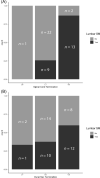Association between filum terminale internum length and pain in Cavalier King Charles spaniels with and without syringomyelia
- PMID: 33426675
- PMCID: PMC7848331
- DOI: 10.1111/jvim.16023
Association between filum terminale internum length and pain in Cavalier King Charles spaniels with and without syringomyelia
Abstract
Background: Lumbar syringomyelia (SM), lumbosacral pain, and more caudal spinal cord termination are reported in Cavalier King Charles spaniels (CKCS). Data are lacking on the clinical relevance of alterations in their spinal cord terminal structures.
Objectives: To compare spinal cord termination level and filum terminale internum length (FTIL) with presence of lumbar SM and clinical signs in CKCS.
Animals: Forty-eight CKCS.
Methods: In this prospective study, pain was quantified using owner and clinician assessments. Vertebral level of spinal cord and dural sac termination, presence of SM, and FTIL were determined from sagittal magnetic resonance imaging (MRI) sequences. Kappa and intraclass correlation (ICC) analyses determined interobserver reliability. The MRI findings were compared to owner and clinician-reported pain quantification.
Results: Interobserver reliability was good for spinal cord and dural sac termination (kappa = 0.61 and 0.64, respectively) and excellent for FTIL (ICC: 92% agreement). The spinal cord terminated at 6th lumbar vertebra in 1, 7th lumbar vertebra in 31, and the sacrum in 15 dogs, and termination level was associated with lumbar SM (P = .002) but not clinical signs. Mean FTIL was 2.9 ± 1.08 mm; it was associated with owner-reported pain (P = .033) and spinal palpation scores (P = .023). Painful CKCS without SM had shorter FTIL compared to normal CKCS and painful CKCS with SM (P = .02).
Conclusions: Painful CKCS without SM have decreased distance between the termination of the spinal cord and dural sac, suggesting a shorter FTIL. More caudal spinal cord termination is associated with development of lumbar SM.
Keywords: Chiari-like malformation; conus medullaris; dural sac; morphometry; tethered cord.
© 2021 The Authors. Journal of Veterinary Internal Medicine published by Wiley Periodicals LLC. on behalf of the American College of Veterinary Internal Medicine.
Conflict of interest statement
Authors declare no conflict of interest.
Figures




Similar articles
-
Morphometric analysis of spinal cord termination in Cavalier King Charles Spaniels.J Vet Intern Med. 2019 Mar;33(2):717-725. doi: 10.1111/jvim.15437. Epub 2019 Feb 13. J Vet Intern Med. 2019. PMID: 30758868 Free PMC article.
-
Questionnaire-based Analysis of Owner-reported Scratching and Pain Signs in Cavalier King Charles Spaniels Screened for Chiari-like Malformation and Syringomyelia.J Vet Intern Med. 2018 Jan;32(1):331-339. doi: 10.1111/jvim.14856. Epub 2017 Nov 4. J Vet Intern Med. 2018. PMID: 29105875 Free PMC article.
-
Comparison of high-field MRI and multidetector CT for grading Chiari-like malformation and syringomyelia in Cavalier King Charles Spaniels.Vet Radiol Ultrasound. 2020 Jul;61(4):444-452. doi: 10.1111/vru.12862. Epub 2020 Apr 24. Vet Radiol Ultrasound. 2020. PMID: 32329949
-
Understanding and Treating Chiari-like Malformation and Syringomyelia in Dogs.Top Companion Anim Med. 2018 Mar;33(1):1-11. doi: 10.1053/j.tcam.2018.03.002. Epub 2018 Mar 15. Top Companion Anim Med. 2018. PMID: 29793722 Review.
-
An update on the pathogenesis of syringomyelia secondary to Chiari-like malformations in dogs.Vet J. 2013 Dec;198(3):551-9. doi: 10.1016/j.tvjl.2013.07.014. Epub 2013 Aug 12. Vet J. 2013. PMID: 23938004 Review.
Cited by
-
Anatomical and histological characterization of the filum terminale in dogs.Front Vet Sci. 2025 Jul 24;12:1650893. doi: 10.3389/fvets.2025.1650893. eCollection 2025. Front Vet Sci. 2025. PMID: 40777825 Free PMC article.
-
Holocord syringomyelia in 18 dogs.Front Vet Sci. 2025 Jan 8;11:1514441. doi: 10.3389/fvets.2024.1514441. eCollection 2024. Front Vet Sci. 2025. PMID: 39846019 Free PMC article.
-
Activity patterns are associated with fractional lifespan, memory, and gait speed in aged dogs.Sci Rep. 2023 Feb 14;13(1):2588. doi: 10.1038/s41598-023-29181-z. Sci Rep. 2023. PMID: 36788306 Free PMC article.
-
Occult tethered cord syndrome: insights into clinical and MRI features, prognostic factors, and treatment outcomes in 30 dogs with confirmed or presumptive diagnosis.Front Vet Sci. 2025 Jul 11;12:1588538. doi: 10.3389/fvets.2025.1588538. eCollection 2025. Front Vet Sci. 2025. PMID: 40717908 Free PMC article.
References
-
- Hechler AC, Moore SA. Understanding and treating Chiari‐like malformation and syringomyelia in dogs. Top Companion Anim Med. 2018;33:1‐11. - PubMed
-
- Rusbridge C, Greitz D, Iskandar BJ. Syringomyelia: current concepts in pathogenesis, diagnosis, and treatment. J Vet Intern Med. 2006;20:469‐479. - PubMed
-
- Carruthers H, Rusbridge C, Dubé M, Holmes M, Jeffery N. Association between cervical and intracranial dimensions and syringomyelia in the Cavalier King Charles spaniel. J Small Anim Pract. 2009;50:394‐398. - PubMed
-
- Loderstedt S, Benigni L, Chandler K, et al. Distribution of syringomyelia along the entire spinal cord in clinically affected Cavalier King Charles spaniels. Vet J. 2011;190:359‐363. - PubMed
MeSH terms
Grants and funding
LinkOut - more resources
Full Text Sources
Other Literature Sources
Medical

